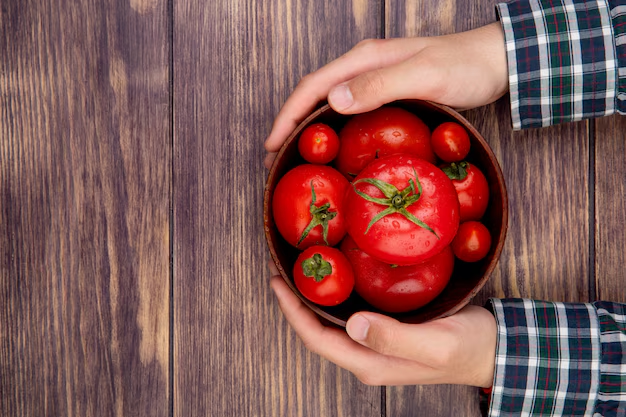Should You Refrigerate Tomatoes? An In-Depth Guide on Tomato Storage
Tomatoes are a staple in kitchens worldwide, thanks to their versatility and rich flavor. Yet, one question continues to baffle home cooks and culinary experts alike: Should tomatoes be stored in the refrigerator? The debate over how to store tomatoes correctly is heated, with valid points on either side. In this comprehensive guide, we'll explore all aspects of tomato storage, offering insights and practical advice to help you make the best decision for your tomatoes — and your taste buds.
🍅 The Tomato Conundrum: To Refrigerate or Not?
The Argument Against Refrigeration
Tomatoes are best known for their juicy texture and robust flavor. Refrigerating tomatoes can negatively impact both these attributes. The cold temperatures inside a refrigerator can damage the cell walls of tomatoes, giving them a mealy texture that's far from appealing. Moreover, the low temperature can dull the natural sugars and acids, leading to a more muted taste.
- Texture Concerns: Tomatoes may become mushy if stored in the fridge.
- Flavor Impact: Cold temperatures can reduce flavor, making tomatoes bland.
The Case for Refrigeration
On the other hand, refrigeration can be beneficial in certain situations. If you have overripe tomatoes that you can't use right away, refrigerating them can slow down the ripening process and prevent spoilage. This is particularly useful if you've bought tomatoes in bulk and want to extend their shelf life.
- Preservation: Helps in delaying spoilage for overripe tomatoes.
- Extended Shelf Life: Particularly useful for longer storage durations.
🍅 Understanding Tomato Ripening Stages
Ripening Science
To make informed decisions about tomato storage, it's essential to understand their ripening process. Tomatoes continue to ripen after being picked, transitioning through several stages from green to perfectly ripe. The ripening process involves complex biochemical changes — largely driven by a compound called ethylene that affects flavor and color transformation.
- Ethylene Production: Acts as a ripening hormone.
- Color Changes: Indicator of ripening progress and flavor depth.
Optimal Storage by Ripeness Level
The way you store tomatoes should largely depend on their current ripeness:
- Unripe (Greenish) Tomatoes: Should be stored at room temperature until they reach the desired ripeness.
- Fully Ripened Tomatoes: Ideal to consume soon after ripening but can be briefly stored in the refrigerator if necessary.
🍅 Best Practices for Room Storage
Ideal Conditions
Room temperature is optimal for storing tomatoes that need to ripen or that you plan to use soon. Here are a few tips:
- Temperature & Humidity: Store in a cool, dry place away from direct sunlight.
- Airflow: Increased airflow can promote even ripening and prevent mold growth.
- Avoid Crowding: Overlapping can hasten spoilage due to elevated ethylene concentration.
Containers and Placement
Choosing the right container and method of placement is key for room storage:
- Counter Cup or Bowl: Use a breathable container to facilitate air circulation.
- Stem-Side Down: Reduces moisture loss and avoids premature bruising.
🍅 Guidelines for Refrigerating Tomatoes
When to Opt for Refrigeration
Refrigeration can be useful for certain circumstances that involve:
- Excess Quantity: If there's a surplus beyond immediate use.
- Very Hot Climates: High temperatures might accelerate spoilage.
Mitigating Cold Damage
Follow these steps to reduce negative impacts from cold storage:
- Wrap in Paper: Minimizes direct moisture contact and absorbs excess humidity.
- Use the Crisper Drawer: This part of the fridge has a slightly higher temperature than other compartments, ideal for storing fruits and vegetables.
🍅 Rehabilitating Cold-Stored Tomatoes
Techniques to Revive Flavor and Texture
If you have refrigerated tomatoes, there are ways to "bring them back to life" before using them:
- Set Out at Room Temperature: Allow them to warm up for a few hours before consumption or cooking.
- Roast or Cook: Use them in sauces or stews where the change in texture isn't detrimental.
🍅 Tomato Storage: A Quick-Reference Guide
To summarize the various considerations around tomato storage, refer to this handy checklist:
| Stage | Storage Method | Notes |
|---|---|---|
| Unripe Tomatoes | Keep at room temperature, ideally in a ventilated space | Will ripen naturally over time. |
| Ripened Tomatoes | Consume quickly or store in the fridge for a short duration if necessary | Brief refrigeration extends freshness. |
| Overripe Tomatoes | Refrigerate to slow down further ripening; Plan to use in cooked dishes soon | Useful for those nearing spoilage. |
🍅 Practical Tips for Everyday Use
Making Smart Use of Tomatoes
- Batch Ripen: Ripen some tomatoes at room temperature while preserving others in the fridge.
- Versatility in Dishes: Use refrigerated tomatoes in sauces or as cooked toppings.
How to Select the Best Tomatoes for Storage
- Check Stem Color & Firmness: For optimal storage, choose firm tomatoes with vibrant stems.
- Inspect for Damage: Avoid those with blemishes or soft spots.
🍅 Final Thoughts
Storing tomatoes can be a nuanced task that depends on multiple factors like ripeness, temperature, and intended use. The question isn't just about where to store them, but when and for how long. With a balanced approach, taking advantage of both room and cold storage as needed, you can ensure that your tomatoes always taste their best.
Ultimately, whether you refrigerate your tomatoes or let them bask at room temperature might also come down to personal preference. Some prefer the extended shelf life, while others can't compromise on texture and taste. By understanding the impact of these storage options, you’re now equipped to make the most informed choice. After all, great storage leads to great meals, and nothing beats the flavor of a perfectly ripe tomato!
